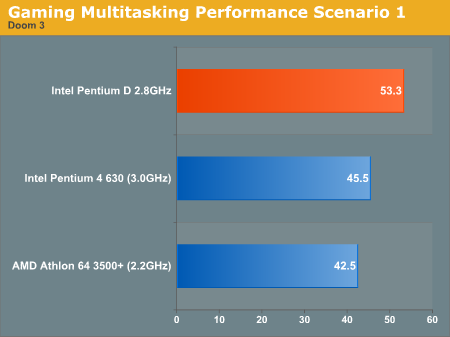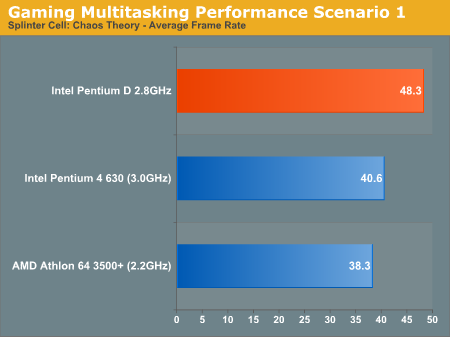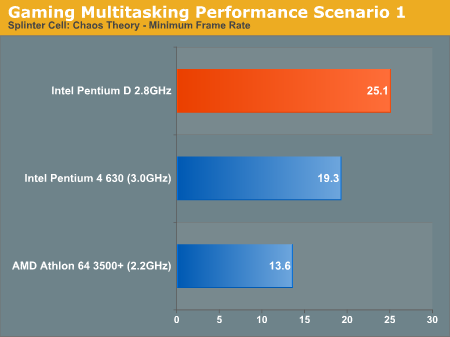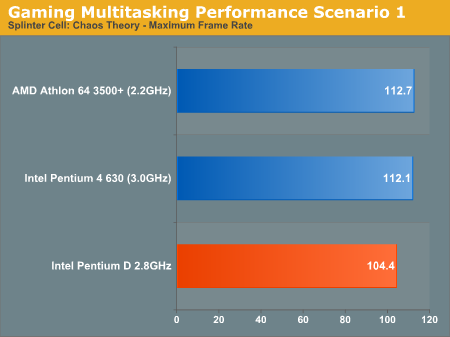Intel Dual Core Performance Preview Part II: A Deeper Look
by Anand Lal Shimpi on April 6, 2005 12:23 PM EST- Posted in
- CPUs
Gaming Multitasking Scenario 1: Heavy Downloading
In the first article, we ran under the assumption that gamers wanted to have as little running in the background while playing a game. While that ended up being true for a lot of folks, we also received quite a bit of feedback asking for some pretty intense multitasking tests while gaming. The requests were far more intense than even the most strenuous setup that we came up with, but because of the demand for such benchmarks, we spent some time putting a few together. Note that this is by no means supposed to be an exhaustive comparison of all gaming scenarios. We are working on creating more and we apologize if your desired scenario didn't make it into this review, but keep sending in suggestions on how you play and we'll do our best to model some benchmarks after how you use your computer.
The first test basically performs all of the tasks from our first Multitasking Scenario, with the exception of DVD Shrink. We have Firefox loaded, but with all 12 tabs from the third test, iTunes is running and playing a playlist, and Newsleecher is downloading headers. We kept Newsleecher in this test simply because it's the best way for us to be able to have a fairly CPU/disk intensive downloading task running in the background while still maintaining some semblance of repeatability. So, replace Newsleecher with BitTorrent or any other resource-consuming downloading that you may be doing and you're good to go.
Of course, Norton AntiVirus 2004 and Microsoft's AntiSpyware Beta were also running in the background.
First, we ran our Doom 3 benchmark:

The tables have now been turned. While the Athlon 64 held a 30% lead with no multitasking, it's now outpaced by both Intel processors, with the Pentium D holding a 25% performance advantage.
It's no surprise that having two cores yield less of a performance impact to having more applications run in the background.
Doom 3 was actually quite playable on both machines; although, loading the game and the levels took a lot longer on the A64, and there's a lot of stuttering during the actual game.
The Pentium 4 platform was quite a bit better, but there is a definite reduction in performance. Obviously, the Pentium D did the best out of the group, but you still notice the performance drop.
Next, we ran the Splinter Cell: Chaos Theory benchmark:



Once again, the Pentium D is ahead of the Athlon 64, but the improvement in minimum frame rates is particularly impressive. The Pentium D offers twice the minimum frame rate of the Athlon 64 in this scenario.










106 Comments
View All Comments
justly - Thursday, April 7, 2005 - link
#84 What do you consider "very soon"?
The following was quoted from "part 1".
"Make no mistake, Intel isn't officially releasing their dual core desktop processors today; this is merely a preview. Intel's dual core line is still on track to be released sometime in the April - June timeframe."
IF it where to be released in April then there should have been more reviews (sorry, previews).
IF it comes out in May then there is no need to do a preview this early (except to gain marketing hype).
IF it comes out in June then a "preview" this early should have contained technical information about the chip with a "review" containing benchmarks at a later date closer to its release date.
jojo4u - Thursday, April 7, 2005 - link
Was Cool'n'Quiet enabled at the power draw test?fitten - Thursday, April 7, 2005 - link
#81, Intel publicly stated that implementing HT on the P4 was about a 5% increase in logic/area on the chip. While it may be "ugly" and such, 5% certainly isn't that much of area when you consider how much area other functionality takes up.#82, I haven't seen anyone announce duel core products. Dual core products, however, should be out very soon from Intel (and are [p]reviewed in the article this discussion is attached) for example). ;)
Kagjes - Thursday, April 7, 2005 - link
I must say i really can't relate to any of these multitasking scenorios. Well, except the teamspeak-gaming part.What would be most interesting for me is dual-core, dual monitor setup. That would ROCK, and i'm really suprised noone remembered that. For instance, playing a divx on 1 monitor while gaming on other. Or watching TV on 1 while gaming on other (i do that a lot, if the football match is boring). These tasks are pretty much repeatable and can be measured. I was thinking about getting another monitor for these kind of purposes, but i'm not sure on how would my comp react to that kind of stress.
justly - Thursday, April 7, 2005 - link
My personal thoughts about publishing an article on a duel core that is not yet availabile, nor will be for awhile, is that it is strictly marketing hype similar to what happened with the 1.13 GHz P3 or any other product that we the consumer have to wait for.The idea that duel core would have a benifit in multitasking or multithreaded apps could have easily been demonstrated on a multiprocessor system using Opterons or Xeons. So now we get a review full of new (wow factor) benchmarks describing the new found benifit of having two processors working together.
I have no real problem with "preview" style articles, but having a plethora of benchmaks in a "preview" is pointless unless the goal is to advertise (hype) a product. The only people I see having any use for this "perview" are the ones that desperately want proof that their manufacturer of choice (this time being Intel) is superior, or those people who are so fickle that they will support the newest thing on the block no matter if it is needed, affordable or even the best option at the time it becomes available.
Quanticles - Thursday, April 7, 2005 - link
Ive heard that HT is very ugly to impliment, you have to tear everything up. I'm not sure HT is very useful when you have dual core anyway.fitten - Thursday, April 7, 2005 - link
#47, if HT is simply a "bandaid", then why is AMD the only major CPU vendor not using it? IBM uses it heavily in their Power5, Sun is making their next CPUs (Niagra) very highly SMT (same thing as HT). Arguably, both of those architectures have much more shallow pipelines than the P4, yet see reason to provide SMT. AMD is the only holdout.dougSF30 - Thursday, April 7, 2005 - link
Make that 2.4GHz in Q3 (not Q4) for the DC Opti 2.4GHz.dougSF30 - Thursday, April 7, 2005 - link
DC A64 samples are at 2.4GHz, not 2.2GHz.DC Opteron is supposedly launching at up to 2.2GHz in a couple weeks, and will be available at 2.4GHz in Q4.
DC Opteron fits in 95W TDP, DC A64 gets a 110W TDP.
Both are apparently 2 x 1MB L2, per the Italian site that put the CeBIT-timed article about the DC A64 sample.
dparish - Thursday, April 7, 2005 - link
Great article. I am confused by one piece:From page 8:
Seagate Barracuda 7200.7 NCQ - 25.2 minutes
Seagate Barracuda 7200.7 no NCQ - 33.6 minutes
Western Digital Raptor WD740 - 30.9 minutes
I'm shocked that the WD740 is slower. Isn't this the NCQ enabled 10,000 rpm drive? I would have expected this to beat out the 7200.7 NCQ seagate. Any reason why the WD740 would be slower?
Another point / comment:
Is it possible that DVD Shrink is slower on the AMD's because it has not been compiled / optimized for the AMD? Would this be any different on the 64 bit version of XP if DVD Shrink was compiled for 64 bit? Of course this may be moot as DVD Shrink is not longer being developed by the author.
-Dave